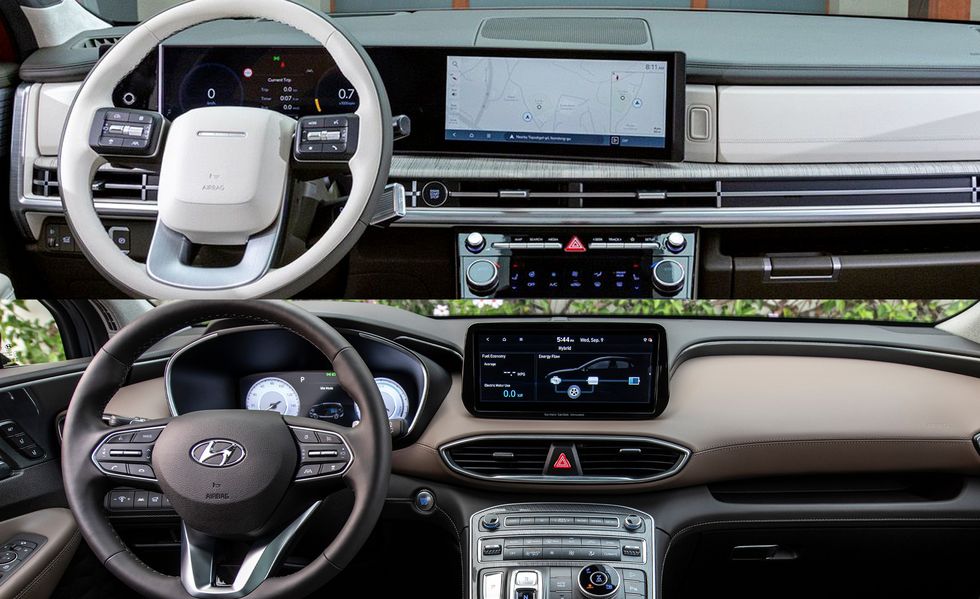2024 Hyundai Santa Fe vs. 2023 Santa Fe: How They Compare

The first-generation Hyundai Santa Fe launched nearly a quarter-century ago in 2000. The introduction of the ute was Hyundai’s first voyage into building and selling SUVs. The Santa Fe debuted to immediate success, quickly becoming the Korean brand’s best-selling car.
Naturally, in the intervening years, the Santa Fe has undergone numerous mechanical and styling changes, entering its fourth generation in 2019. For the 2024 model year, the fifth-generation Santa Fe looks as different from the fourth as a square does to a circle. In fact, the new version looks more like a Land Rover Defender than it does its predecessor.
Because they’re so visually divergent, we’ve compared the new Santa Fe to the old one to better understand the differences.
Dimensions and Design
When it debuted, the fourth-generation Santa Fe brought handsome changes to the mid-size SUV. The grille’s polygonal design delivered a more modern look, while the interior had a simple, straightforward layout. While the inside wasn’t luxurious, it was comfortable and ergonomically friendly. It also brought rear glass that was more vertical than its predecessor, improving rear-seat headroom and cargo space.
The new fifth-generation Santa Fe brings a much more in-your-face design that we find handsome. The rear window that became more vertical between the last two generations is once again more vertical. Hyundai claims the change helps improve rear-seat headroom and cargo space. The H-shaped elements in the Santa Fe’s headlights and taillights correspond with its boxy body, practically shouting “HYUNDAI!” Lest you forget what you’re looking at.
Hyundai
The 2024 Santa Fe is 1.8 inches longer than the outgoing model and now measures 190.2 inches from tip to tail. The new version’s wheelbase also grows by 1.9 inches to 110.8 inches. Hyundai claims the longer wheelbase and squared-off rear end help provide better passenger space and cargo capacity. The redesigned tailgate is nearly perpendicular to the ground and provides a bigger opening than before.
Both the new and old Santa Fe measure 74.8 inches wide, though the 2024 model measures between 1.1 and 1.8 inches taller. Adding roof rails adds an additional 2 inches of height. Inside, second-row legroom has improved too, growing by 0.8 inch for the hybrid model and 1.4 inches for the gas-only model.
Interior
If the new Santa Fe’s exterior looks like it was created by someone working from their memory of a Land Rover Defender, the interior looks like it was designed by someone sitting in an actual Defender. The Hyundai’s cabin is considerably more upscale than before, with a redesigned three-spoke steering wheel that looks like it may have been pulled straight off the Land Rover production line.
Perhaps the most important distinction between the new Santa Fe and the last version is the inclusion of third-row seating. While models in other markets were offered with the extra row, those sold in the U.S. only had two rows of seats. With the new second- and third-row seats folded flat, there’s a continuous space for storage behind the front seats

Hyundai
The dash of the ’24 brings dual 12.3-inch screens under the same curved piece, matching other recent Hyundai models. The “H” design from the headlights and taillights is borrowed for the dashboard air vents and divides new upper and lower gloveboxes. The new Santa Fe also gets dual wireless charging pads for smartphones and a UV-C Sanitizer tray on top of the glovebox.
Powertrain Options
Both the standard 2.5-liter four-cylinder engine that produced 191 horsepower as well as the 260-hp plug-in-hybrid powertrain have been dropped in the U.S. in the transition to the new generation. Instead, the new Santa Fe that’s sold on our shores comes with two powertrain choices. There’s a turbocharged 2.5-liter four-cylinder that produces 277 horses and 311 pound-feet of torque. It mates to an eight-speed dual-clutch automatic transmission and either front- or all-wheel drive.
If that doesn’t sound suitable, Hyundai also ports over the hybrid powertrain with the turbo 1.6-liter four-cylinder and six-speed automatic transmission. The company hasn’t revealed the official combined power output, but we were told to expect similar figures to the last version. That setup featured an electric motor working with the four-pot to generate a combined 226 horsepower.
Expected Price
Unfortunately, the loss of the base engine, increased cabin flair, and growth of the vehicle conjure up a recipe for a more expensive mid-size SUV. The last model started a hair over $30,000, with the cheapest hybrid option starting in the $37,000 range. Our expectation is that the new version will start somewhere in that same ballpark, possibly around $38K. We think the rest of the trim options will follow up-market as well, topping out with the top-of-the-line Calligraphy trim likely starting somewhere near the $50,000 mark, which is about $6K more than that version of the outgoing Santa Fe.
Hyundai says the 2024 Santa Fe will reach U.S. dealerships sometime in the first half of next year.
This content is imported from poll. You may be able to find the same content in another format, or you may be able to find more information, at their web site.

Associate News Editor
Jack Fitzgerald’s love for cars stems from his as yet unshakable addiction to Formula 1.
After a brief stint as a detailer for a local dealership group in college, he knew he needed a more permanent way to drive all the new cars he couldn’t afford and decided to pursue a career in auto writing. By hounding his college professors at the University of Wisconsin-Milwaukee, he was able to travel Wisconsin seeking out stories in the auto world before landing his dream job at Car and Driver. His new goal is to delay the inevitable demise of his 2010 Volkswagen Golf.





